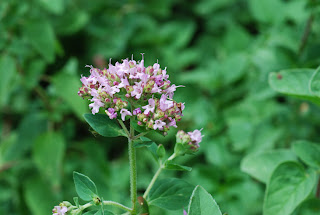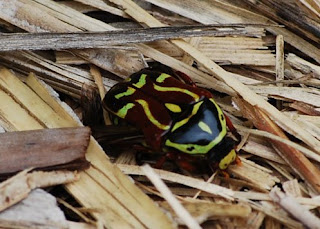It wasn't until I lived in a house with a tin roof that I realised what I had been missing all those years – the gentle hiss of rain. I had grown up in a house with a tiled roof, and that thick layer of terracotta roofing might have had its advantages, but it prevented me listening to all but the heaviest rain. Now I have a bit of both worlds: a tiled roof over our bedrooms and living rooms, and a tin roof over the back part of the house, where the kitchen and bathroom is. And so this morning I was up early, in the kitchen as usual, reading, and I heard the first raindrops. As soon as the light was good, I headed outdoors.
 Easily the prettiest raindrop-holders here would have to be the Brussels sprouts. Every raindrop holds its place on those stiff, veined leaves. None of the raindrops is a perfect sphere, each does its own take on the saggy side of sogginess.
Easily the prettiest raindrop-holders here would have to be the Brussels sprouts. Every raindrop holds its place on those stiff, veined leaves. None of the raindrops is a perfect sphere, each does its own take on the saggy side of sogginess. New growth on roses comes second! This is a standard Friesia rose I'm minding for a friend, Evan. I read somewhere that there's a reason for new growth being red. The chemical that makes it red is similar to a sunscreen, and helps to protect the baby leaves from sunburn in its first few weeks of life.
New growth on roses comes second! This is a standard Friesia rose I'm minding for a friend, Evan. I read somewhere that there's a reason for new growth being red. The chemical that makes it red is similar to a sunscreen, and helps to protect the baby leaves from sunburn in its first few weeks of life. Finally, this little pot of mini Cos lettuce is underway in the improving warmth and rain. They had been doing very little for the last two weeks, not any more, and they'll quickly fill the pot.
Finally, this little pot of mini Cos lettuce is underway in the improving warmth and rain. They had been doing very little for the last two weeks, not any more, and they'll quickly fill the pot. It's easy to see how broccoli is related to Brussels Sprouts. They both hold water in giant blobs that shimmer slightly in the breeze. While I was taking photos this morning, these same blobs just stayed put for the half-hour or so I was outside.
It's easy to see how broccoli is related to Brussels Sprouts. They both hold water in giant blobs that shimmer slightly in the breeze. While I was taking photos this morning, these same blobs just stayed put for the half-hour or so I was outside. Even the plants that supposedly don't need much water look like they're lapping it up. This pot of succulent aeoniums likes a drink more than some other succulents.
Even the plants that supposedly don't need much water look like they're lapping it up. This pot of succulent aeoniums likes a drink more than some other succulents. As usual I'm not certain whether these are graptoverias or something else in the succulent kingdom, but they turn water into another substance that looks more like a synthetic jelly than simple H20.
As usual I'm not certain whether these are graptoverias or something else in the succulent kingdom, but they turn water into another substance that looks more like a synthetic jelly than simple H20. Of course the ferns thrive on water. Considering how dry Sydney has been, I am amazed that any of my ferns have survived, but then again ferns have survived several hundred million years, through ice ages and everything else that nature can throw at them, so a mere Australian drought is probably a 'been there, done that a thousand times' kind of thing for a fern.
Of course the ferns thrive on water. Considering how dry Sydney has been, I am amazed that any of my ferns have survived, but then again ferns have survived several hundred million years, through ice ages and everything else that nature can throw at them, so a mere Australian drought is probably a 'been there, done that a thousand times' kind of thing for a fern. Now, this is not a paid commercial by any means, but I couldn't possibly post about a rainy day without including something about fertiliser. A wet day is the perfect day for fertilising gardens. All the magazines and books say to water gardens before and after fertilising, so if you wander about in the rain scattering the chicken poo (which is largely what Dynamic Lifter is) the rain does the rest. This is what I mostly use on my garden. It smells glorious for a day or two, it's gentle and a well-balanced plant and soil food. Cow manure and home-made compost make their contribution, but this best-selling manure is just so convenient to buy and apply. Other brands of chicken manure are out there, and they're just as good. I just use this stuff because it's so readily available.
Now, this is not a paid commercial by any means, but I couldn't possibly post about a rainy day without including something about fertiliser. A wet day is the perfect day for fertilising gardens. All the magazines and books say to water gardens before and after fertilising, so if you wander about in the rain scattering the chicken poo (which is largely what Dynamic Lifter is) the rain does the rest. This is what I mostly use on my garden. It smells glorious for a day or two, it's gentle and a well-balanced plant and soil food. Cow manure and home-made compost make their contribution, but this best-selling manure is just so convenient to buy and apply. Other brands of chicken manure are out there, and they're just as good. I just use this stuff because it's so readily available. Although Dynamic Lifter is acceptable even for Australian native plants, you have to be careful how much you use. Australian natives are incredibly sensitive to phosphorus, and most ordinary garden fertilisers will kill them very quickly. So you have to use special plant foods formulated for natives, if you use anything at all. As my native garden is actually my front garden, where a lot of people walk by each day, I defer to sensitive noses and, instead of smelly Dynamic Lifter, I use a slow-release fertiliser, which has no odour. All I have to do is spread one little pack like this around all the natives in early spring, and that's it for the year. The natives thrive so much that the only job is cutting them back, to keep them dense and to stop them mugging passers-by.
Although Dynamic Lifter is acceptable even for Australian native plants, you have to be careful how much you use. Australian natives are incredibly sensitive to phosphorus, and most ordinary garden fertilisers will kill them very quickly. So you have to use special plant foods formulated for natives, if you use anything at all. As my native garden is actually my front garden, where a lot of people walk by each day, I defer to sensitive noses and, instead of smelly Dynamic Lifter, I use a slow-release fertiliser, which has no odour. All I have to do is spread one little pack like this around all the natives in early spring, and that's it for the year. The natives thrive so much that the only job is cutting them back, to keep them dense and to stop them mugging passers-by.  I keep track of how much rain my garden gets with a simple rain gauge. I'm often surprised by how little, or how much, rain falls some days, and the gauge has proved useful a hundred times over. It definitely saves on over-watering. And yes, I do have other gardening friends around the city with gauges, and sometimes I get emails from them saying something like: "25mm last night" and that's it. I might reply "18mm here" and no more needs to be said. All the faithful record-keeping brings out the 19th-century scientist in this Garden Amateur!
I keep track of how much rain my garden gets with a simple rain gauge. I'm often surprised by how little, or how much, rain falls some days, and the gauge has proved useful a hundred times over. It definitely saves on over-watering. And yes, I do have other gardening friends around the city with gauges, and sometimes I get emails from them saying something like: "25mm last night" and that's it. I might reply "18mm here" and no more needs to be said. All the faithful record-keeping brings out the 19th-century scientist in this Garden Amateur! 



























